Research Skills Report: Data Analysis, Interpretation, and Ethics
VerifiedAdded on 2022/11/28
|11
|3814
|382
Report
AI Summary
This report provides a comprehensive overview of research skills, covering key aspects such as data types, collection methods, and analysis techniques. It explores the differences between data, information, and knowledge, and discusses the use of both primary and secondary data sources. The report delves into the process of data collection, including the use of questionnaires and the evaluation of source credibility. It also addresses the importance of data analysis, interpretation, and the use of data for decision-making, including the application of SMART goals. Furthermore, the report highlights the significance of information security systems and ethical considerations in research. The report offers a reflective account of the skills learned throughout the module, emphasizing the practical application of research methodologies and the challenges encountered during the research process. It also provides a detailed analysis of the importance of data driven decision making and the security aspects of data.
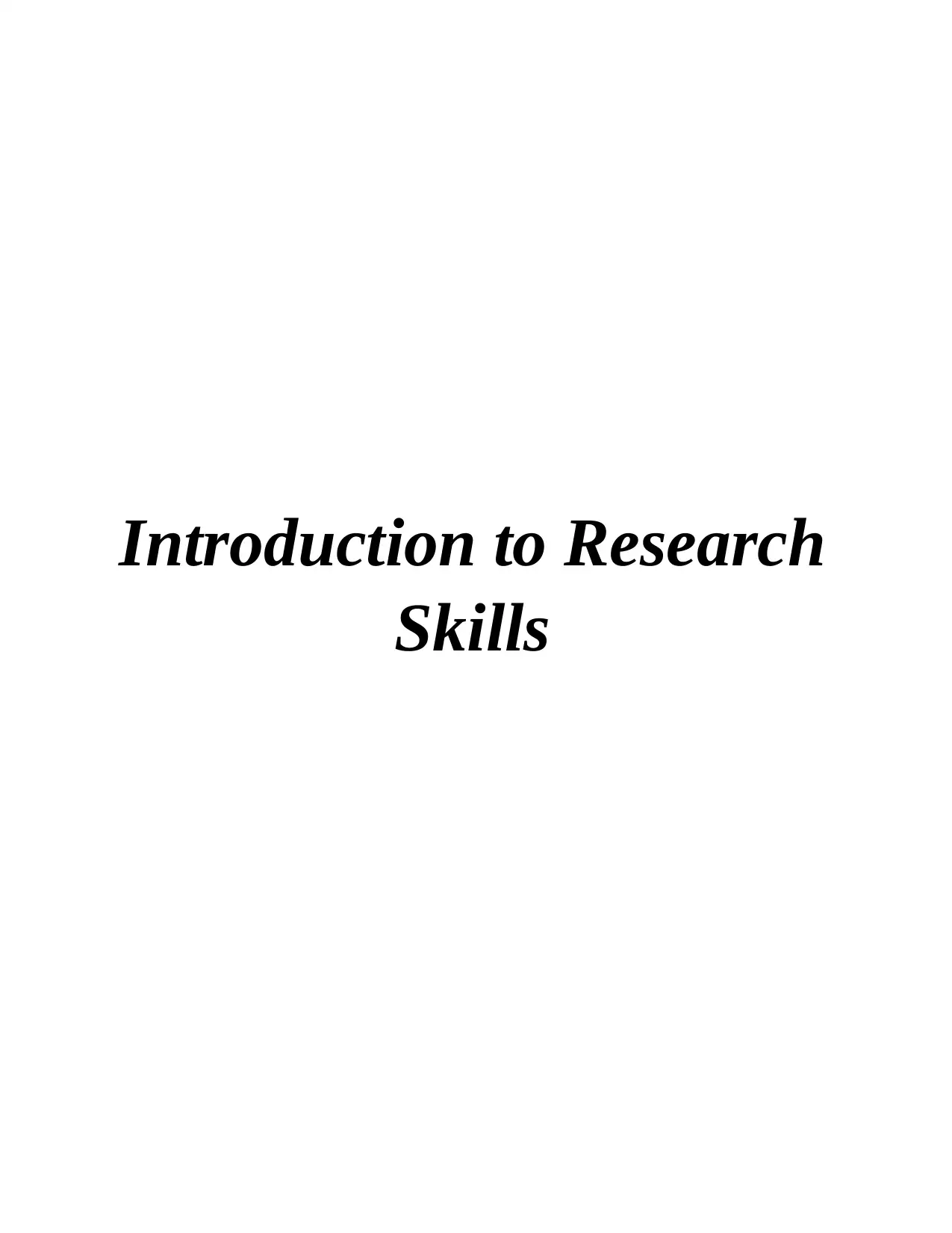
Introduction to Research
Skills
Skills
Paraphrase This Document
Need a fresh take? Get an instant paraphrase of this document with our AI Paraphraser
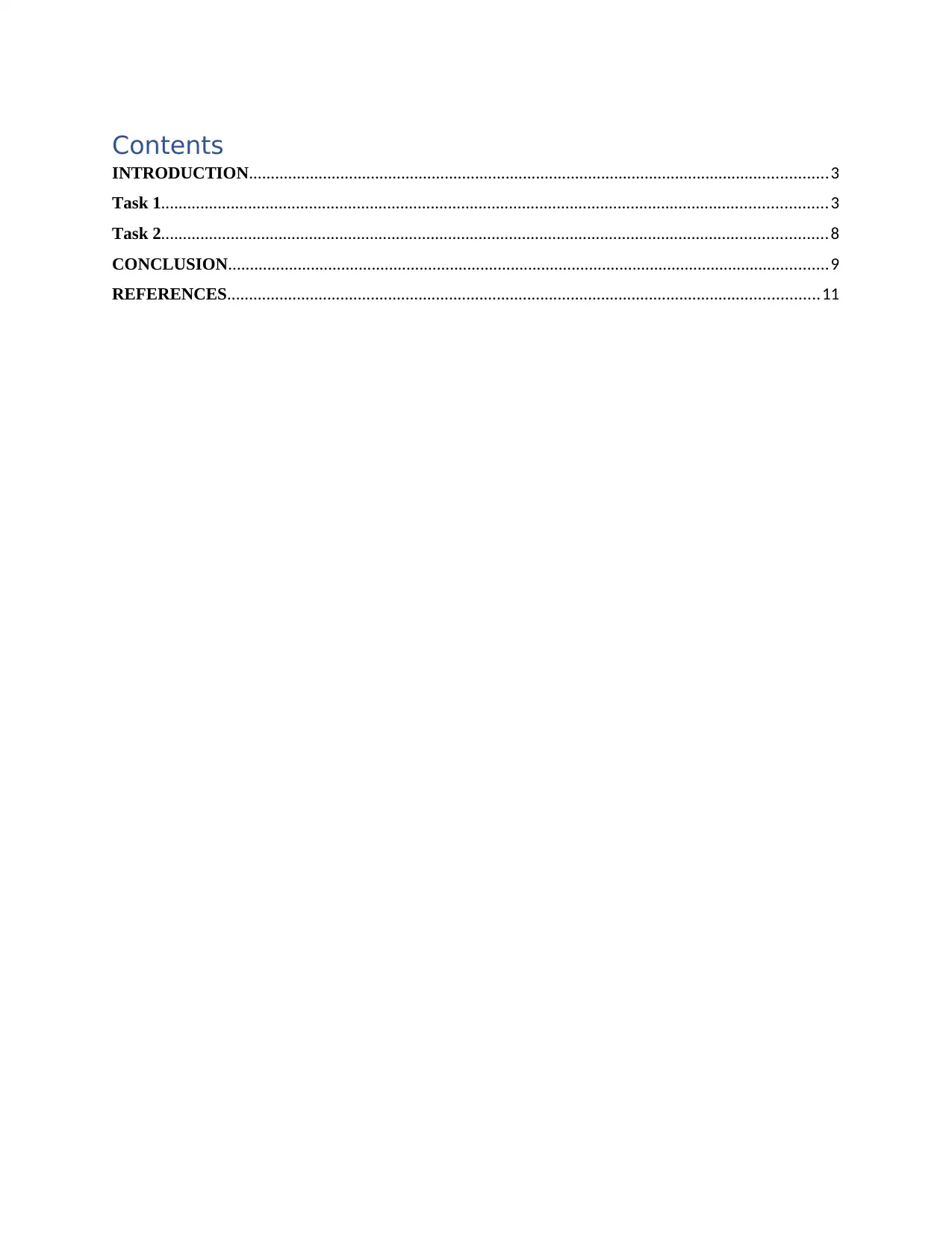
Contents
INTRODUCTION.....................................................................................................................................3
Task 1.........................................................................................................................................................3
Task 2.........................................................................................................................................................8
CONCLUSION..........................................................................................................................................9
REFERENCES........................................................................................................................................11
INTRODUCTION.....................................................................................................................................3
Task 1.........................................................................................................................................................3
Task 2.........................................................................................................................................................8
CONCLUSION..........................................................................................................................................9
REFERENCES........................................................................................................................................11
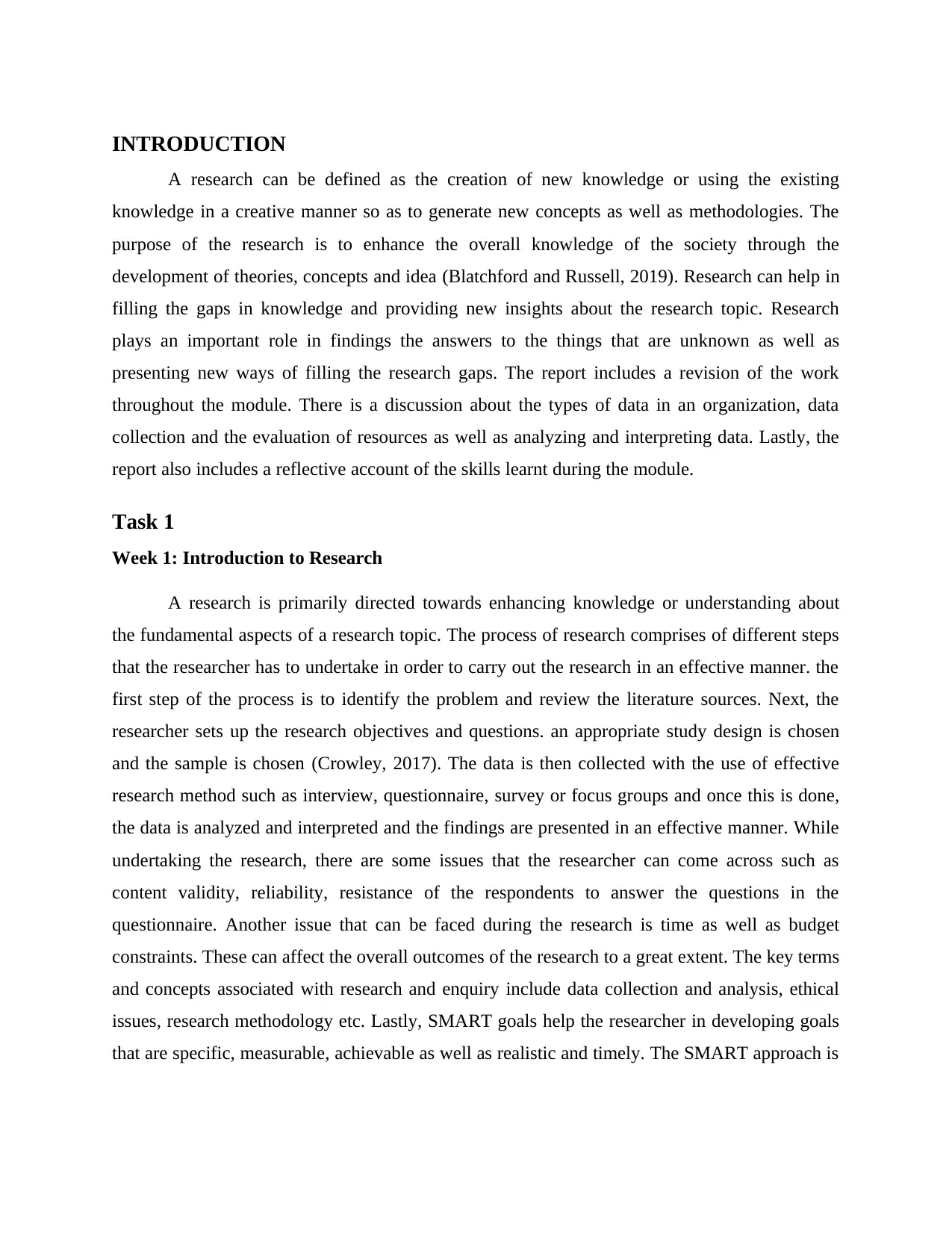
INTRODUCTION
A research can be defined as the creation of new knowledge or using the existing
knowledge in a creative manner so as to generate new concepts as well as methodologies. The
purpose of the research is to enhance the overall knowledge of the society through the
development of theories, concepts and idea (Blatchford and Russell, 2019). Research can help in
filling the gaps in knowledge and providing new insights about the research topic. Research
plays an important role in findings the answers to the things that are unknown as well as
presenting new ways of filling the research gaps. The report includes a revision of the work
throughout the module. There is a discussion about the types of data in an organization, data
collection and the evaluation of resources as well as analyzing and interpreting data. Lastly, the
report also includes a reflective account of the skills learnt during the module.
Task 1
Week 1: Introduction to Research
A research is primarily directed towards enhancing knowledge or understanding about
the fundamental aspects of a research topic. The process of research comprises of different steps
that the researcher has to undertake in order to carry out the research in an effective manner. the
first step of the process is to identify the problem and review the literature sources. Next, the
researcher sets up the research objectives and questions. an appropriate study design is chosen
and the sample is chosen (Crowley, 2017). The data is then collected with the use of effective
research method such as interview, questionnaire, survey or focus groups and once this is done,
the data is analyzed and interpreted and the findings are presented in an effective manner. While
undertaking the research, there are some issues that the researcher can come across such as
content validity, reliability, resistance of the respondents to answer the questions in the
questionnaire. Another issue that can be faced during the research is time as well as budget
constraints. These can affect the overall outcomes of the research to a great extent. The key terms
and concepts associated with research and enquiry include data collection and analysis, ethical
issues, research methodology etc. Lastly, SMART goals help the researcher in developing goals
that are specific, measurable, achievable as well as realistic and timely. The SMART approach is
A research can be defined as the creation of new knowledge or using the existing
knowledge in a creative manner so as to generate new concepts as well as methodologies. The
purpose of the research is to enhance the overall knowledge of the society through the
development of theories, concepts and idea (Blatchford and Russell, 2019). Research can help in
filling the gaps in knowledge and providing new insights about the research topic. Research
plays an important role in findings the answers to the things that are unknown as well as
presenting new ways of filling the research gaps. The report includes a revision of the work
throughout the module. There is a discussion about the types of data in an organization, data
collection and the evaluation of resources as well as analyzing and interpreting data. Lastly, the
report also includes a reflective account of the skills learnt during the module.
Task 1
Week 1: Introduction to Research
A research is primarily directed towards enhancing knowledge or understanding about
the fundamental aspects of a research topic. The process of research comprises of different steps
that the researcher has to undertake in order to carry out the research in an effective manner. the
first step of the process is to identify the problem and review the literature sources. Next, the
researcher sets up the research objectives and questions. an appropriate study design is chosen
and the sample is chosen (Crowley, 2017). The data is then collected with the use of effective
research method such as interview, questionnaire, survey or focus groups and once this is done,
the data is analyzed and interpreted and the findings are presented in an effective manner. While
undertaking the research, there are some issues that the researcher can come across such as
content validity, reliability, resistance of the respondents to answer the questions in the
questionnaire. Another issue that can be faced during the research is time as well as budget
constraints. These can affect the overall outcomes of the research to a great extent. The key terms
and concepts associated with research and enquiry include data collection and analysis, ethical
issues, research methodology etc. Lastly, SMART goals help the researcher in developing goals
that are specific, measurable, achievable as well as realistic and timely. The SMART approach is
You're viewing a preview
Unlock full access by subscribing today!
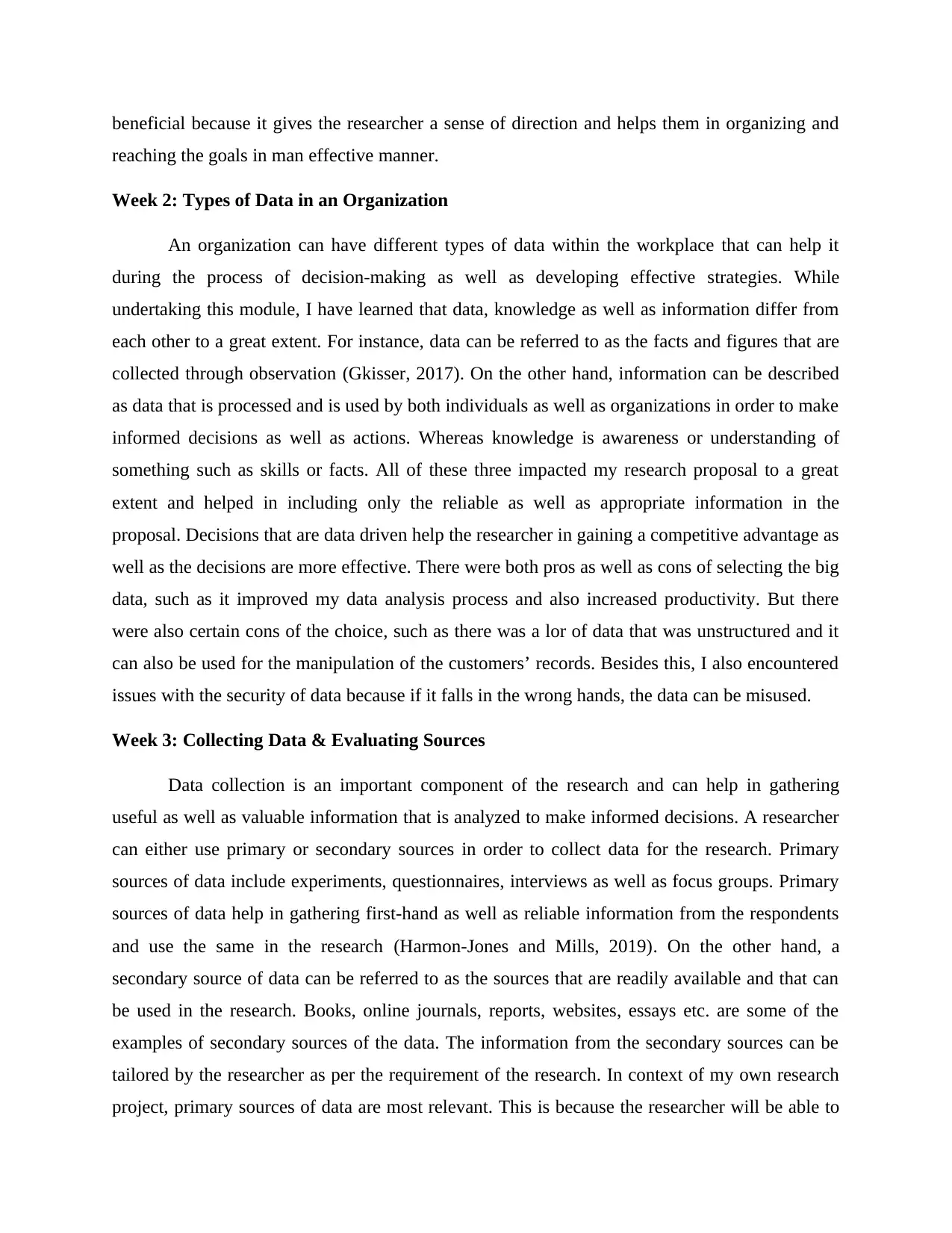
beneficial because it gives the researcher a sense of direction and helps them in organizing and
reaching the goals in man effective manner.
Week 2: Types of Data in an Organization
An organization can have different types of data within the workplace that can help it
during the process of decision-making as well as developing effective strategies. While
undertaking this module, I have learned that data, knowledge as well as information differ from
each other to a great extent. For instance, data can be referred to as the facts and figures that are
collected through observation (Gkisser, 2017). On the other hand, information can be described
as data that is processed and is used by both individuals as well as organizations in order to make
informed decisions as well as actions. Whereas knowledge is awareness or understanding of
something such as skills or facts. All of these three impacted my research proposal to a great
extent and helped in including only the reliable as well as appropriate information in the
proposal. Decisions that are data driven help the researcher in gaining a competitive advantage as
well as the decisions are more effective. There were both pros as well as cons of selecting the big
data, such as it improved my data analysis process and also increased productivity. But there
were also certain cons of the choice, such as there was a lor of data that was unstructured and it
can also be used for the manipulation of the customers’ records. Besides this, I also encountered
issues with the security of data because if it falls in the wrong hands, the data can be misused.
Week 3: Collecting Data & Evaluating Sources
Data collection is an important component of the research and can help in gathering
useful as well as valuable information that is analyzed to make informed decisions. A researcher
can either use primary or secondary sources in order to collect data for the research. Primary
sources of data include experiments, questionnaires, interviews as well as focus groups. Primary
sources of data help in gathering first-hand as well as reliable information from the respondents
and use the same in the research (Harmon-Jones and Mills, 2019). On the other hand, a
secondary source of data can be referred to as the sources that are readily available and that can
be used in the research. Books, online journals, reports, websites, essays etc. are some of the
examples of secondary sources of the data. The information from the secondary sources can be
tailored by the researcher as per the requirement of the research. In context of my own research
project, primary sources of data are most relevant. This is because the researcher will be able to
reaching the goals in man effective manner.
Week 2: Types of Data in an Organization
An organization can have different types of data within the workplace that can help it
during the process of decision-making as well as developing effective strategies. While
undertaking this module, I have learned that data, knowledge as well as information differ from
each other to a great extent. For instance, data can be referred to as the facts and figures that are
collected through observation (Gkisser, 2017). On the other hand, information can be described
as data that is processed and is used by both individuals as well as organizations in order to make
informed decisions as well as actions. Whereas knowledge is awareness or understanding of
something such as skills or facts. All of these three impacted my research proposal to a great
extent and helped in including only the reliable as well as appropriate information in the
proposal. Decisions that are data driven help the researcher in gaining a competitive advantage as
well as the decisions are more effective. There were both pros as well as cons of selecting the big
data, such as it improved my data analysis process and also increased productivity. But there
were also certain cons of the choice, such as there was a lor of data that was unstructured and it
can also be used for the manipulation of the customers’ records. Besides this, I also encountered
issues with the security of data because if it falls in the wrong hands, the data can be misused.
Week 3: Collecting Data & Evaluating Sources
Data collection is an important component of the research and can help in gathering
useful as well as valuable information that is analyzed to make informed decisions. A researcher
can either use primary or secondary sources in order to collect data for the research. Primary
sources of data include experiments, questionnaires, interviews as well as focus groups. Primary
sources of data help in gathering first-hand as well as reliable information from the respondents
and use the same in the research (Harmon-Jones and Mills, 2019). On the other hand, a
secondary source of data can be referred to as the sources that are readily available and that can
be used in the research. Books, online journals, reports, websites, essays etc. are some of the
examples of secondary sources of the data. The information from the secondary sources can be
tailored by the researcher as per the requirement of the research. In context of my own research
project, primary sources of data are most relevant. This is because the researcher will be able to
Paraphrase This Document
Need a fresh take? Get an instant paraphrase of this document with our AI Paraphraser
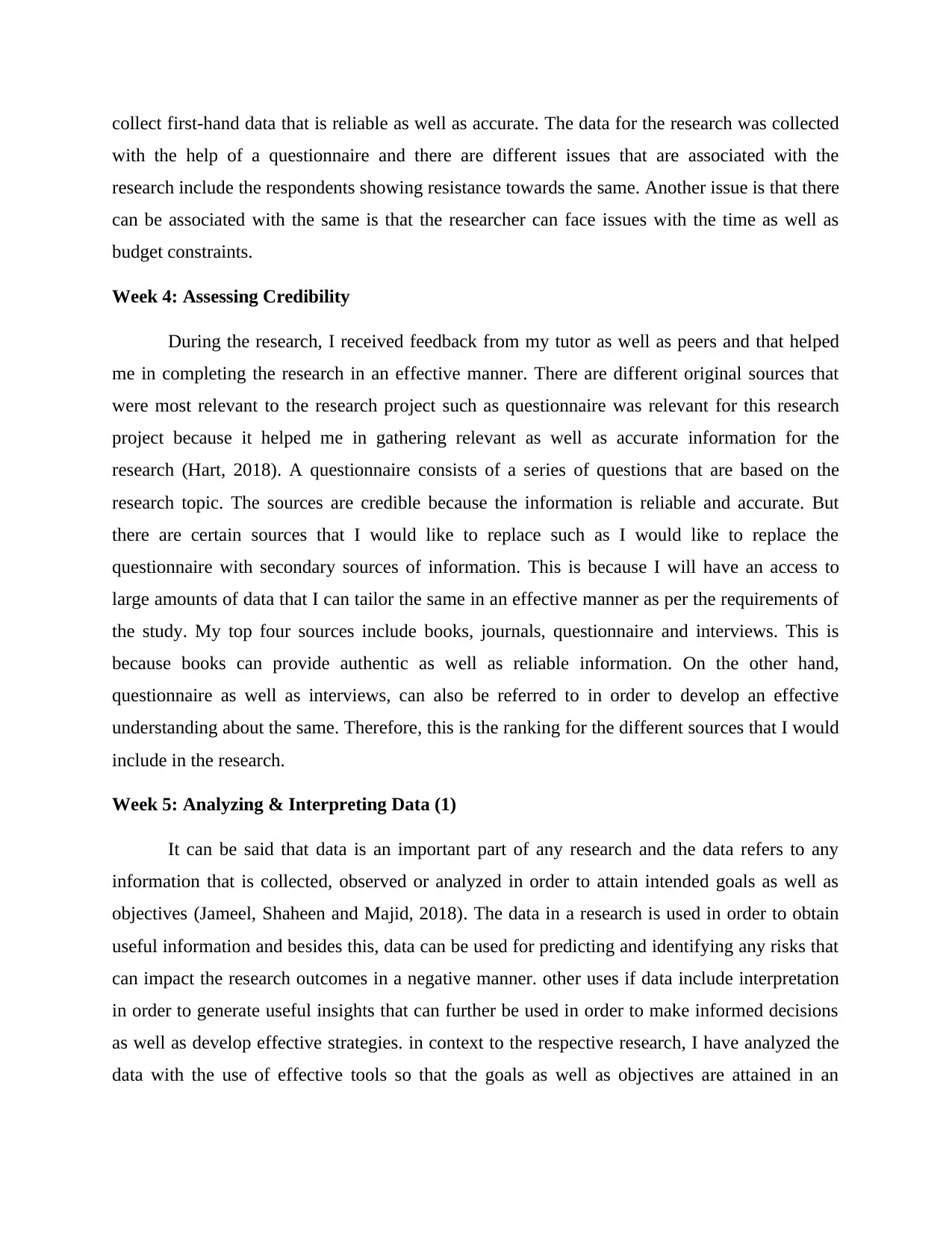
collect first-hand data that is reliable as well as accurate. The data for the research was collected
with the help of a questionnaire and there are different issues that are associated with the
research include the respondents showing resistance towards the same. Another issue is that there
can be associated with the same is that the researcher can face issues with the time as well as
budget constraints.
Week 4: Assessing Credibility
During the research, I received feedback from my tutor as well as peers and that helped
me in completing the research in an effective manner. There are different original sources that
were most relevant to the research project such as questionnaire was relevant for this research
project because it helped me in gathering relevant as well as accurate information for the
research (Hart, 2018). A questionnaire consists of a series of questions that are based on the
research topic. The sources are credible because the information is reliable and accurate. But
there are certain sources that I would like to replace such as I would like to replace the
questionnaire with secondary sources of information. This is because I will have an access to
large amounts of data that I can tailor the same in an effective manner as per the requirements of
the study. My top four sources include books, journals, questionnaire and interviews. This is
because books can provide authentic as well as reliable information. On the other hand,
questionnaire as well as interviews, can also be referred to in order to develop an effective
understanding about the same. Therefore, this is the ranking for the different sources that I would
include in the research.
Week 5: Analyzing & Interpreting Data (1)
It can be said that data is an important part of any research and the data refers to any
information that is collected, observed or analyzed in order to attain intended goals as well as
objectives (Jameel, Shaheen and Majid, 2018). The data in a research is used in order to obtain
useful information and besides this, data can be used for predicting and identifying any risks that
can impact the research outcomes in a negative manner. other uses if data include interpretation
in order to generate useful insights that can further be used in order to make informed decisions
as well as develop effective strategies. in context to the respective research, I have analyzed the
data with the use of effective tools so that the goals as well as objectives are attained in an
with the help of a questionnaire and there are different issues that are associated with the
research include the respondents showing resistance towards the same. Another issue is that there
can be associated with the same is that the researcher can face issues with the time as well as
budget constraints.
Week 4: Assessing Credibility
During the research, I received feedback from my tutor as well as peers and that helped
me in completing the research in an effective manner. There are different original sources that
were most relevant to the research project such as questionnaire was relevant for this research
project because it helped me in gathering relevant as well as accurate information for the
research (Hart, 2018). A questionnaire consists of a series of questions that are based on the
research topic. The sources are credible because the information is reliable and accurate. But
there are certain sources that I would like to replace such as I would like to replace the
questionnaire with secondary sources of information. This is because I will have an access to
large amounts of data that I can tailor the same in an effective manner as per the requirements of
the study. My top four sources include books, journals, questionnaire and interviews. This is
because books can provide authentic as well as reliable information. On the other hand,
questionnaire as well as interviews, can also be referred to in order to develop an effective
understanding about the same. Therefore, this is the ranking for the different sources that I would
include in the research.
Week 5: Analyzing & Interpreting Data (1)
It can be said that data is an important part of any research and the data refers to any
information that is collected, observed or analyzed in order to attain intended goals as well as
objectives (Jameel, Shaheen and Majid, 2018). The data in a research is used in order to obtain
useful information and besides this, data can be used for predicting and identifying any risks that
can impact the research outcomes in a negative manner. other uses if data include interpretation
in order to generate useful insights that can further be used in order to make informed decisions
as well as develop effective strategies. in context to the respective research, I have analyzed the
data with the use of effective tools so that the goals as well as objectives are attained in an
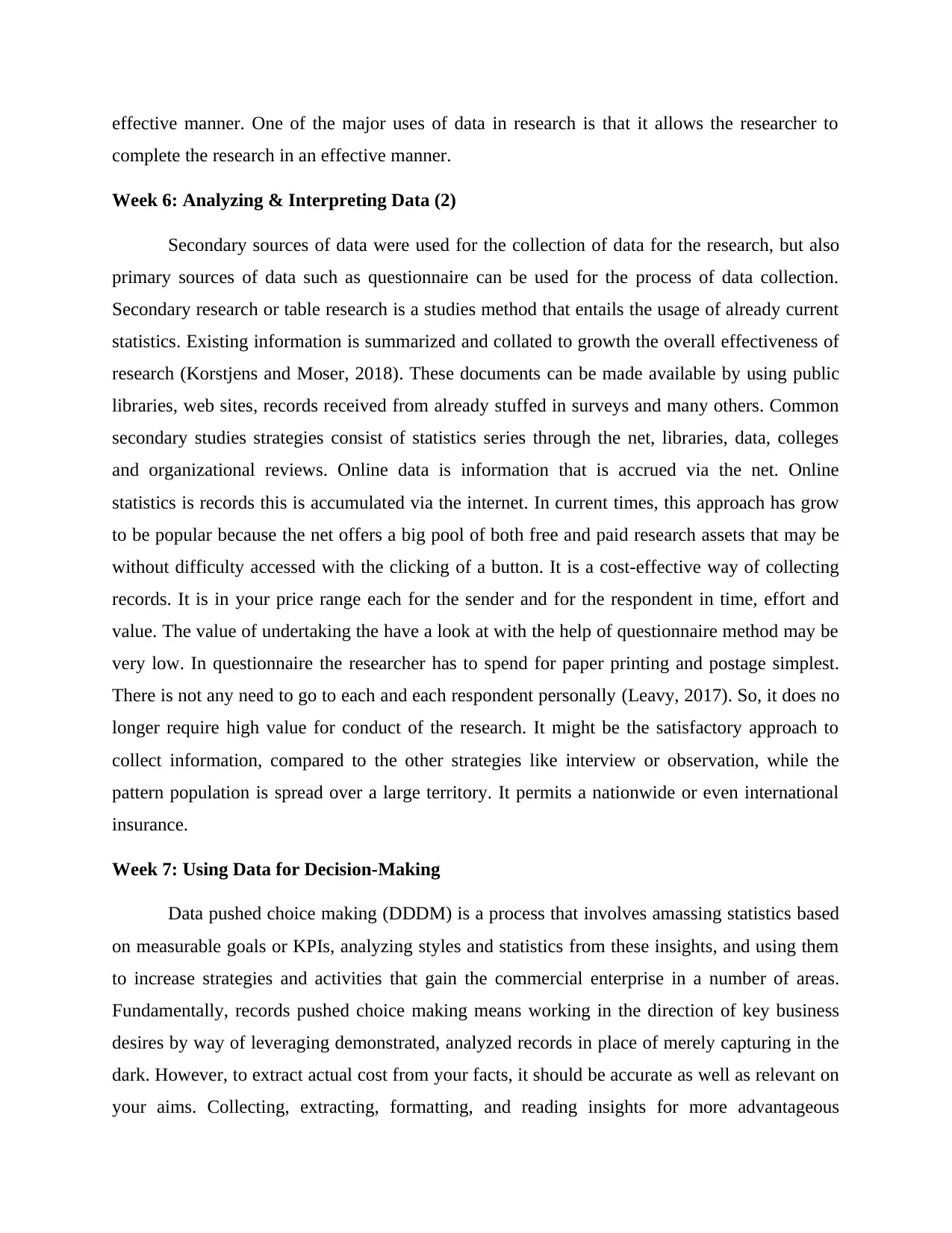
effective manner. One of the major uses of data in research is that it allows the researcher to
complete the research in an effective manner.
Week 6: Analyzing & Interpreting Data (2)
Secondary sources of data were used for the collection of data for the research, but also
primary sources of data such as questionnaire can be used for the process of data collection.
Secondary research or table research is a studies method that entails the usage of already current
statistics. Existing information is summarized and collated to growth the overall effectiveness of
research (Korstjens and Moser, 2018). These documents can be made available by using public
libraries, web sites, records received from already stuffed in surveys and many others. Common
secondary studies strategies consist of statistics series through the net, libraries, data, colleges
and organizational reviews. Online data is information that is accrued via the net. Online
statistics is records this is accumulated via the internet. In current times, this approach has grow
to be popular because the net offers a big pool of both free and paid research assets that may be
without difficulty accessed with the clicking of a button. It is a cost-effective way of collecting
records. It is in your price range each for the sender and for the respondent in time, effort and
value. The value of undertaking the have a look at with the help of questionnaire method may be
very low. In questionnaire the researcher has to spend for paper printing and postage simplest.
There is not any need to go to each and each respondent personally (Leavy, 2017). So, it does no
longer require high value for conduct of the research. It might be the satisfactory approach to
collect information, compared to the other strategies like interview or observation, while the
pattern population is spread over a large territory. It permits a nationwide or even international
insurance.
Week 7: Using Data for Decision-Making
Data pushed choice making (DDDM) is a process that involves amassing statistics based
on measurable goals or KPIs, analyzing styles and statistics from these insights, and using them
to increase strategies and activities that gain the commercial enterprise in a number of areas.
Fundamentally, records pushed choice making means working in the direction of key business
desires by way of leveraging demonstrated, analyzed records in place of merely capturing in the
dark. However, to extract actual cost from your facts, it should be accurate as well as relevant on
your aims. Collecting, extracting, formatting, and reading insights for more advantageous
complete the research in an effective manner.
Week 6: Analyzing & Interpreting Data (2)
Secondary sources of data were used for the collection of data for the research, but also
primary sources of data such as questionnaire can be used for the process of data collection.
Secondary research or table research is a studies method that entails the usage of already current
statistics. Existing information is summarized and collated to growth the overall effectiveness of
research (Korstjens and Moser, 2018). These documents can be made available by using public
libraries, web sites, records received from already stuffed in surveys and many others. Common
secondary studies strategies consist of statistics series through the net, libraries, data, colleges
and organizational reviews. Online data is information that is accrued via the net. Online
statistics is records this is accumulated via the internet. In current times, this approach has grow
to be popular because the net offers a big pool of both free and paid research assets that may be
without difficulty accessed with the clicking of a button. It is a cost-effective way of collecting
records. It is in your price range each for the sender and for the respondent in time, effort and
value. The value of undertaking the have a look at with the help of questionnaire method may be
very low. In questionnaire the researcher has to spend for paper printing and postage simplest.
There is not any need to go to each and each respondent personally (Leavy, 2017). So, it does no
longer require high value for conduct of the research. It might be the satisfactory approach to
collect information, compared to the other strategies like interview or observation, while the
pattern population is spread over a large territory. It permits a nationwide or even international
insurance.
Week 7: Using Data for Decision-Making
Data pushed choice making (DDDM) is a process that involves amassing statistics based
on measurable goals or KPIs, analyzing styles and statistics from these insights, and using them
to increase strategies and activities that gain the commercial enterprise in a number of areas.
Fundamentally, records pushed choice making means working in the direction of key business
desires by way of leveraging demonstrated, analyzed records in place of merely capturing in the
dark. However, to extract actual cost from your facts, it should be accurate as well as relevant on
your aims. Collecting, extracting, formatting, and reading insights for more advantageous
You're viewing a preview
Unlock full access by subscribing today!
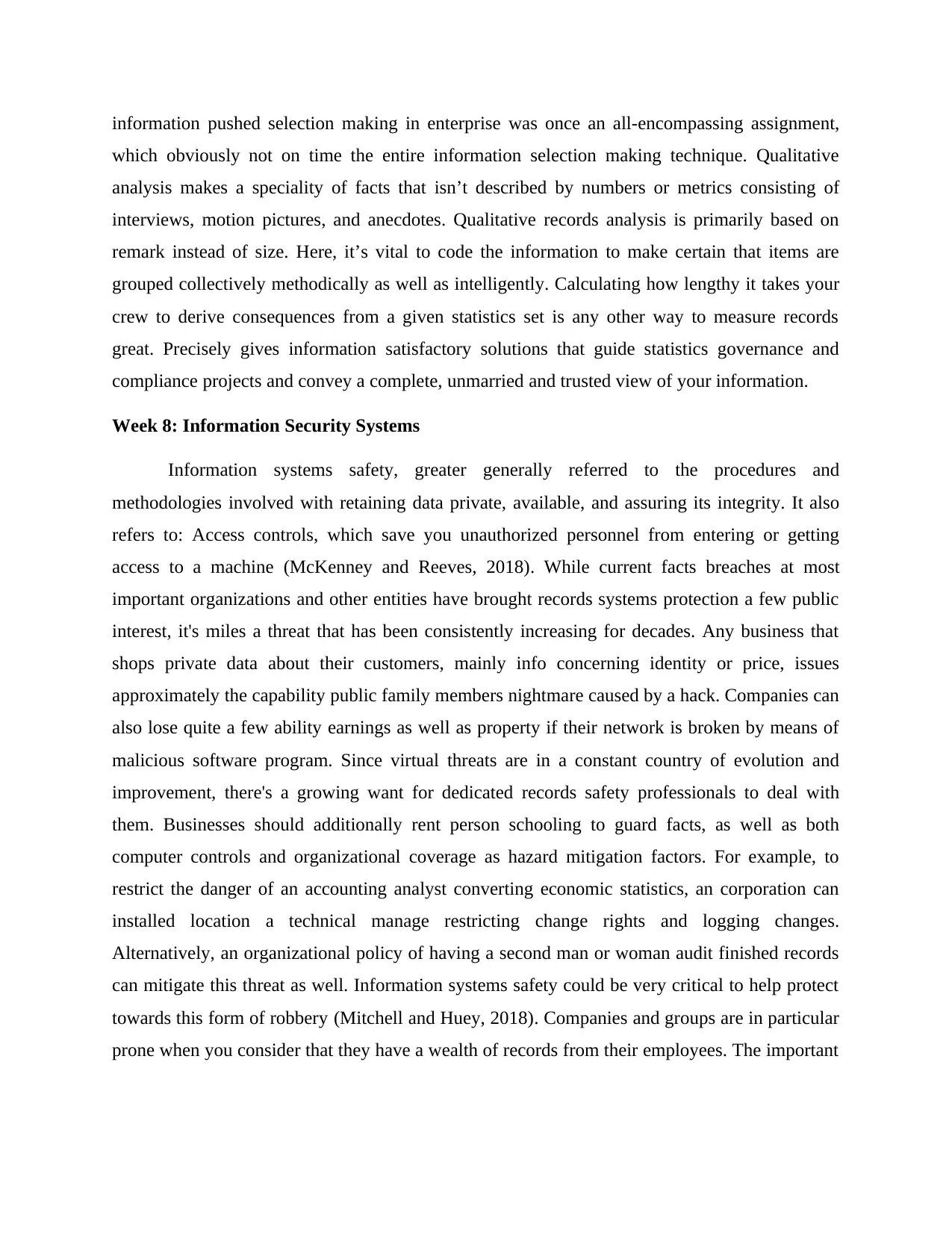
information pushed selection making in enterprise was once an all-encompassing assignment,
which obviously not on time the entire information selection making technique. Qualitative
analysis makes a speciality of facts that isn’t described by numbers or metrics consisting of
interviews, motion pictures, and anecdotes. Qualitative records analysis is primarily based on
remark instead of size. Here, it’s vital to code the information to make certain that items are
grouped collectively methodically as well as intelligently. Calculating how lengthy it takes your
crew to derive consequences from a given statistics set is any other way to measure records
great. Precisely gives information satisfactory solutions that guide statistics governance and
compliance projects and convey a complete, unmarried and trusted view of your information.
Week 8: Information Security Systems
Information systems safety, greater generally referred to the procedures and
methodologies involved with retaining data private, available, and assuring its integrity. It also
refers to: Access controls, which save you unauthorized personnel from entering or getting
access to a machine (McKenney and Reeves, 2018). While current facts breaches at most
important organizations and other entities have brought records systems protection a few public
interest, it's miles a threat that has been consistently increasing for decades. Any business that
shops private data about their customers, mainly info concerning identity or price, issues
approximately the capability public family members nightmare caused by a hack. Companies can
also lose quite a few ability earnings as well as property if their network is broken by means of
malicious software program. Since virtual threats are in a constant country of evolution and
improvement, there's a growing want for dedicated records safety professionals to deal with
them. Businesses should additionally rent person schooling to guard facts, as well as both
computer controls and organizational coverage as hazard mitigation factors. For example, to
restrict the danger of an accounting analyst converting economic statistics, an corporation can
installed location a technical manage restricting change rights and logging changes.
Alternatively, an organizational policy of having a second man or woman audit finished records
can mitigate this threat as well. Information systems safety could be very critical to help protect
towards this form of robbery (Mitchell and Huey, 2018). Companies and groups are in particular
prone when you consider that they have a wealth of records from their employees. The important
which obviously not on time the entire information selection making technique. Qualitative
analysis makes a speciality of facts that isn’t described by numbers or metrics consisting of
interviews, motion pictures, and anecdotes. Qualitative records analysis is primarily based on
remark instead of size. Here, it’s vital to code the information to make certain that items are
grouped collectively methodically as well as intelligently. Calculating how lengthy it takes your
crew to derive consequences from a given statistics set is any other way to measure records
great. Precisely gives information satisfactory solutions that guide statistics governance and
compliance projects and convey a complete, unmarried and trusted view of your information.
Week 8: Information Security Systems
Information systems safety, greater generally referred to the procedures and
methodologies involved with retaining data private, available, and assuring its integrity. It also
refers to: Access controls, which save you unauthorized personnel from entering or getting
access to a machine (McKenney and Reeves, 2018). While current facts breaches at most
important organizations and other entities have brought records systems protection a few public
interest, it's miles a threat that has been consistently increasing for decades. Any business that
shops private data about their customers, mainly info concerning identity or price, issues
approximately the capability public family members nightmare caused by a hack. Companies can
also lose quite a few ability earnings as well as property if their network is broken by means of
malicious software program. Since virtual threats are in a constant country of evolution and
improvement, there's a growing want for dedicated records safety professionals to deal with
them. Businesses should additionally rent person schooling to guard facts, as well as both
computer controls and organizational coverage as hazard mitigation factors. For example, to
restrict the danger of an accounting analyst converting economic statistics, an corporation can
installed location a technical manage restricting change rights and logging changes.
Alternatively, an organizational policy of having a second man or woman audit finished records
can mitigate this threat as well. Information systems safety could be very critical to help protect
towards this form of robbery (Mitchell and Huey, 2018). Companies and groups are in particular
prone when you consider that they have a wealth of records from their employees. The important
Paraphrase This Document
Need a fresh take? Get an instant paraphrase of this document with our AI Paraphraser
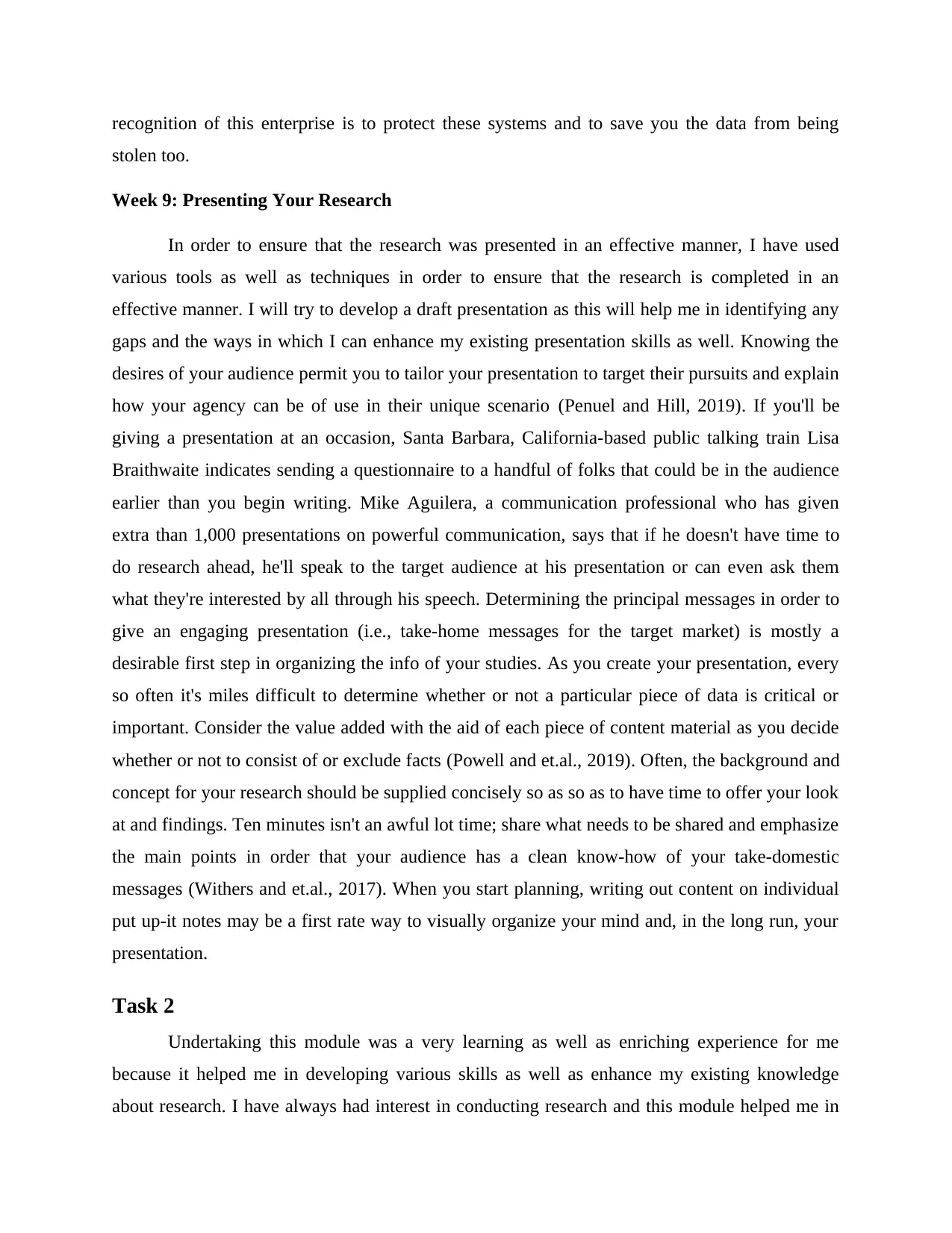
recognition of this enterprise is to protect these systems and to save you the data from being
stolen too.
Week 9: Presenting Your Research
In order to ensure that the research was presented in an effective manner, I have used
various tools as well as techniques in order to ensure that the research is completed in an
effective manner. I will try to develop a draft presentation as this will help me in identifying any
gaps and the ways in which I can enhance my existing presentation skills as well. Knowing the
desires of your audience permit you to tailor your presentation to target their pursuits and explain
how your agency can be of use in their unique scenario (Penuel and Hill, 2019). If you'll be
giving a presentation at an occasion, Santa Barbara, California-based public talking train Lisa
Braithwaite indicates sending a questionnaire to a handful of folks that could be in the audience
earlier than you begin writing. Mike Aguilera, a communication professional who has given
extra than 1,000 presentations on powerful communication, says that if he doesn't have time to
do research ahead, he'll speak to the target audience at his presentation or can even ask them
what they're interested by all through his speech. Determining the principal messages in order to
give an engaging presentation (i.e., take-home messages for the target market) is mostly a
desirable first step in organizing the info of your studies. As you create your presentation, every
so often it's miles difficult to determine whether or not a particular piece of data is critical or
important. Consider the value added with the aid of each piece of content material as you decide
whether or not to consist of or exclude facts (Powell and et.al., 2019). Often, the background and
concept for your research should be supplied concisely so as so as to have time to offer your look
at and findings. Ten minutes isn't an awful lot time; share what needs to be shared and emphasize
the main points in order that your audience has a clean know-how of your take-domestic
messages (Withers and et.al., 2017). When you start planning, writing out content on individual
put up-it notes may be a first rate way to visually organize your mind and, in the long run, your
presentation.
Task 2
Undertaking this module was a very learning as well as enriching experience for me
because it helped me in developing various skills as well as enhance my existing knowledge
about research. I have always had interest in conducting research and this module helped me in
stolen too.
Week 9: Presenting Your Research
In order to ensure that the research was presented in an effective manner, I have used
various tools as well as techniques in order to ensure that the research is completed in an
effective manner. I will try to develop a draft presentation as this will help me in identifying any
gaps and the ways in which I can enhance my existing presentation skills as well. Knowing the
desires of your audience permit you to tailor your presentation to target their pursuits and explain
how your agency can be of use in their unique scenario (Penuel and Hill, 2019). If you'll be
giving a presentation at an occasion, Santa Barbara, California-based public talking train Lisa
Braithwaite indicates sending a questionnaire to a handful of folks that could be in the audience
earlier than you begin writing. Mike Aguilera, a communication professional who has given
extra than 1,000 presentations on powerful communication, says that if he doesn't have time to
do research ahead, he'll speak to the target audience at his presentation or can even ask them
what they're interested by all through his speech. Determining the principal messages in order to
give an engaging presentation (i.e., take-home messages for the target market) is mostly a
desirable first step in organizing the info of your studies. As you create your presentation, every
so often it's miles difficult to determine whether or not a particular piece of data is critical or
important. Consider the value added with the aid of each piece of content material as you decide
whether or not to consist of or exclude facts (Powell and et.al., 2019). Often, the background and
concept for your research should be supplied concisely so as so as to have time to offer your look
at and findings. Ten minutes isn't an awful lot time; share what needs to be shared and emphasize
the main points in order that your audience has a clean know-how of your take-domestic
messages (Withers and et.al., 2017). When you start planning, writing out content on individual
put up-it notes may be a first rate way to visually organize your mind and, in the long run, your
presentation.
Task 2
Undertaking this module was a very learning as well as enriching experience for me
because it helped me in developing various skills as well as enhance my existing knowledge
about research. I have always had interest in conducting research and this module helped me in
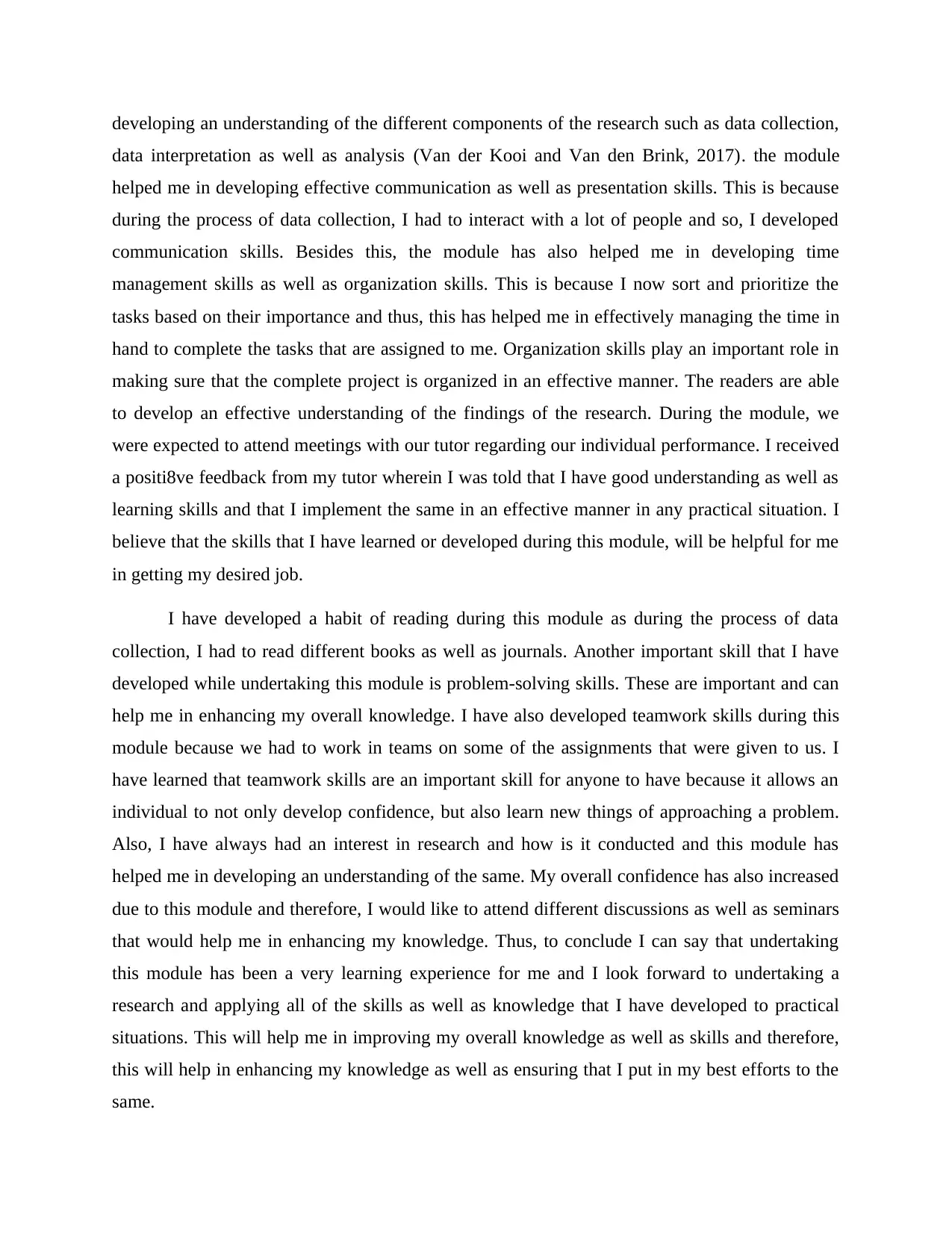
developing an understanding of the different components of the research such as data collection,
data interpretation as well as analysis (Van der Kooi and Van den Brink, 2017). the module
helped me in developing effective communication as well as presentation skills. This is because
during the process of data collection, I had to interact with a lot of people and so, I developed
communication skills. Besides this, the module has also helped me in developing time
management skills as well as organization skills. This is because I now sort and prioritize the
tasks based on their importance and thus, this has helped me in effectively managing the time in
hand to complete the tasks that are assigned to me. Organization skills play an important role in
making sure that the complete project is organized in an effective manner. The readers are able
to develop an effective understanding of the findings of the research. During the module, we
were expected to attend meetings with our tutor regarding our individual performance. I received
a positi8ve feedback from my tutor wherein I was told that I have good understanding as well as
learning skills and that I implement the same in an effective manner in any practical situation. I
believe that the skills that I have learned or developed during this module, will be helpful for me
in getting my desired job.
I have developed a habit of reading during this module as during the process of data
collection, I had to read different books as well as journals. Another important skill that I have
developed while undertaking this module is problem-solving skills. These are important and can
help me in enhancing my overall knowledge. I have also developed teamwork skills during this
module because we had to work in teams on some of the assignments that were given to us. I
have learned that teamwork skills are an important skill for anyone to have because it allows an
individual to not only develop confidence, but also learn new things of approaching a problem.
Also, I have always had an interest in research and how is it conducted and this module has
helped me in developing an understanding of the same. My overall confidence has also increased
due to this module and therefore, I would like to attend different discussions as well as seminars
that would help me in enhancing my knowledge. Thus, to conclude I can say that undertaking
this module has been a very learning experience for me and I look forward to undertaking a
research and applying all of the skills as well as knowledge that I have developed to practical
situations. This will help me in improving my overall knowledge as well as skills and therefore,
this will help in enhancing my knowledge as well as ensuring that I put in my best efforts to the
same.
data interpretation as well as analysis (Van der Kooi and Van den Brink, 2017). the module
helped me in developing effective communication as well as presentation skills. This is because
during the process of data collection, I had to interact with a lot of people and so, I developed
communication skills. Besides this, the module has also helped me in developing time
management skills as well as organization skills. This is because I now sort and prioritize the
tasks based on their importance and thus, this has helped me in effectively managing the time in
hand to complete the tasks that are assigned to me. Organization skills play an important role in
making sure that the complete project is organized in an effective manner. The readers are able
to develop an effective understanding of the findings of the research. During the module, we
were expected to attend meetings with our tutor regarding our individual performance. I received
a positi8ve feedback from my tutor wherein I was told that I have good understanding as well as
learning skills and that I implement the same in an effective manner in any practical situation. I
believe that the skills that I have learned or developed during this module, will be helpful for me
in getting my desired job.
I have developed a habit of reading during this module as during the process of data
collection, I had to read different books as well as journals. Another important skill that I have
developed while undertaking this module is problem-solving skills. These are important and can
help me in enhancing my overall knowledge. I have also developed teamwork skills during this
module because we had to work in teams on some of the assignments that were given to us. I
have learned that teamwork skills are an important skill for anyone to have because it allows an
individual to not only develop confidence, but also learn new things of approaching a problem.
Also, I have always had an interest in research and how is it conducted and this module has
helped me in developing an understanding of the same. My overall confidence has also increased
due to this module and therefore, I would like to attend different discussions as well as seminars
that would help me in enhancing my knowledge. Thus, to conclude I can say that undertaking
this module has been a very learning experience for me and I look forward to undertaking a
research and applying all of the skills as well as knowledge that I have developed to practical
situations. This will help me in improving my overall knowledge as well as skills and therefore,
this will help in enhancing my knowledge as well as ensuring that I put in my best efforts to the
same.
You're viewing a preview
Unlock full access by subscribing today!
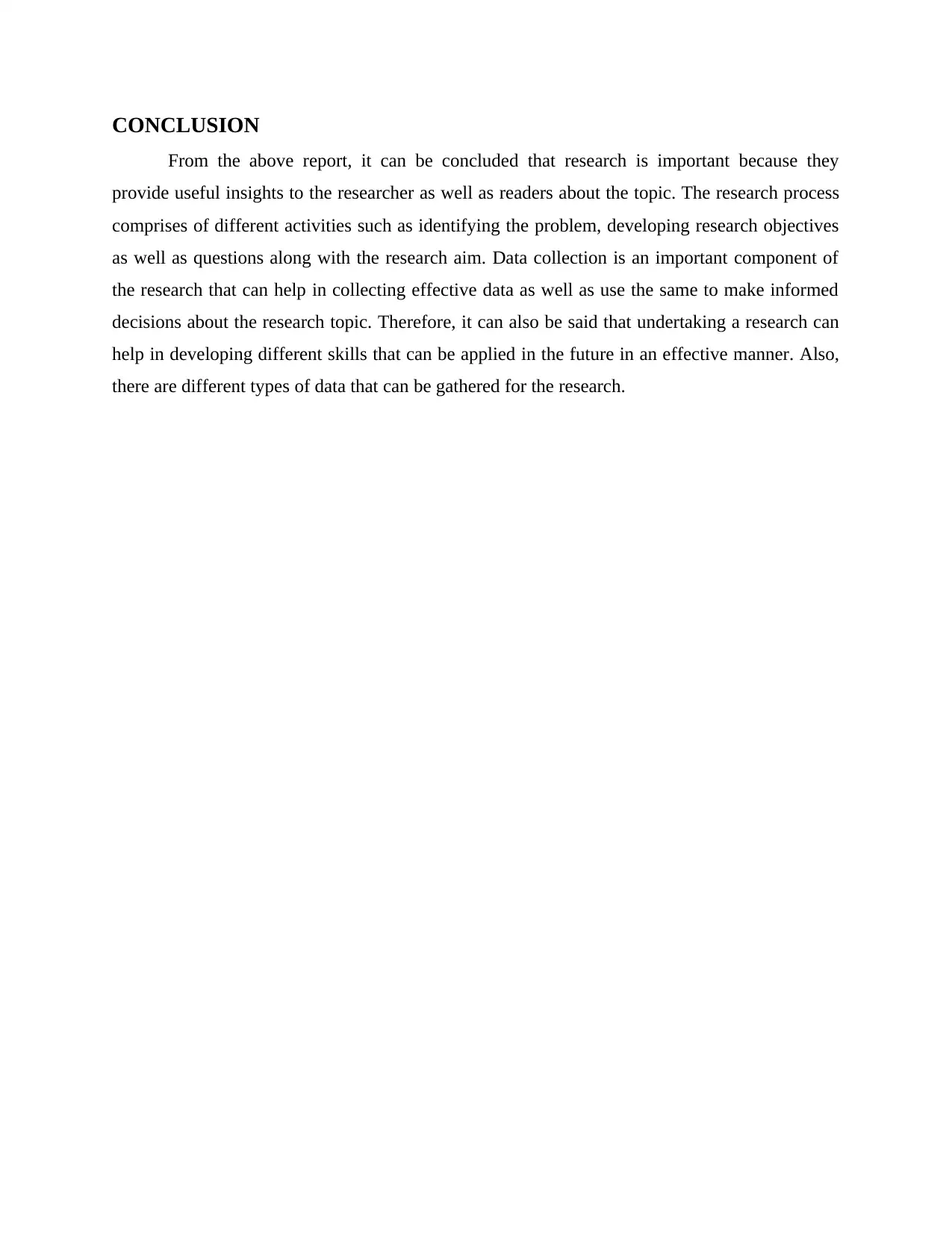
CONCLUSION
From the above report, it can be concluded that research is important because they
provide useful insights to the researcher as well as readers about the topic. The research process
comprises of different activities such as identifying the problem, developing research objectives
as well as questions along with the research aim. Data collection is an important component of
the research that can help in collecting effective data as well as use the same to make informed
decisions about the research topic. Therefore, it can also be said that undertaking a research can
help in developing different skills that can be applied in the future in an effective manner. Also,
there are different types of data that can be gathered for the research.
From the above report, it can be concluded that research is important because they
provide useful insights to the researcher as well as readers about the topic. The research process
comprises of different activities such as identifying the problem, developing research objectives
as well as questions along with the research aim. Data collection is an important component of
the research that can help in collecting effective data as well as use the same to make informed
decisions about the research topic. Therefore, it can also be said that undertaking a research can
help in developing different skills that can be applied in the future in an effective manner. Also,
there are different types of data that can be gathered for the research.
Paraphrase This Document
Need a fresh take? Get an instant paraphrase of this document with our AI Paraphraser
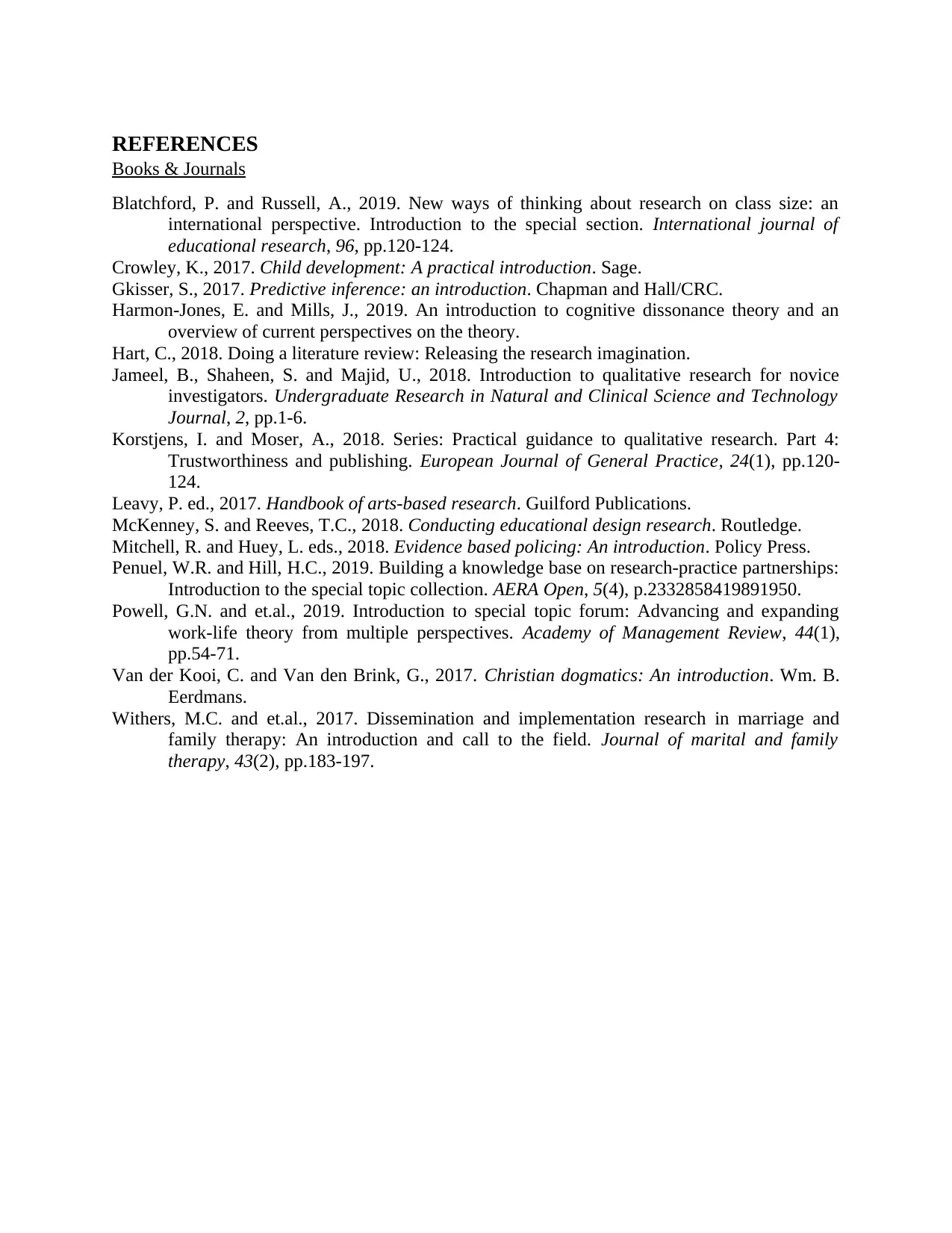
REFERENCES
Books & Journals
Blatchford, P. and Russell, A., 2019. New ways of thinking about research on class size: an
international perspective. Introduction to the special section. International journal of
educational research, 96, pp.120-124.
Crowley, K., 2017. Child development: A practical introduction. Sage.
Gkisser, S., 2017. Predictive inference: an introduction. Chapman and Hall/CRC.
Harmon-Jones, E. and Mills, J., 2019. An introduction to cognitive dissonance theory and an
overview of current perspectives on the theory.
Hart, C., 2018. Doing a literature review: Releasing the research imagination.
Jameel, B., Shaheen, S. and Majid, U., 2018. Introduction to qualitative research for novice
investigators. Undergraduate Research in Natural and Clinical Science and Technology
Journal, 2, pp.1-6.
Korstjens, I. and Moser, A., 2018. Series: Practical guidance to qualitative research. Part 4:
Trustworthiness and publishing. European Journal of General Practice, 24(1), pp.120-
124.
Leavy, P. ed., 2017. Handbook of arts-based research. Guilford Publications.
McKenney, S. and Reeves, T.C., 2018. Conducting educational design research. Routledge.
Mitchell, R. and Huey, L. eds., 2018. Evidence based policing: An introduction. Policy Press.
Penuel, W.R. and Hill, H.C., 2019. Building a knowledge base on research-practice partnerships:
Introduction to the special topic collection. AERA Open, 5(4), p.2332858419891950.
Powell, G.N. and et.al., 2019. Introduction to special topic forum: Advancing and expanding
work-life theory from multiple perspectives. Academy of Management Review, 44(1),
pp.54-71.
Van der Kooi, C. and Van den Brink, G., 2017. Christian dogmatics: An introduction. Wm. B.
Eerdmans.
Withers, M.C. and et.al., 2017. Dissemination and implementation research in marriage and
family therapy: An introduction and call to the field. Journal of marital and family
therapy, 43(2), pp.183-197.
Books & Journals
Blatchford, P. and Russell, A., 2019. New ways of thinking about research on class size: an
international perspective. Introduction to the special section. International journal of
educational research, 96, pp.120-124.
Crowley, K., 2017. Child development: A practical introduction. Sage.
Gkisser, S., 2017. Predictive inference: an introduction. Chapman and Hall/CRC.
Harmon-Jones, E. and Mills, J., 2019. An introduction to cognitive dissonance theory and an
overview of current perspectives on the theory.
Hart, C., 2018. Doing a literature review: Releasing the research imagination.
Jameel, B., Shaheen, S. and Majid, U., 2018. Introduction to qualitative research for novice
investigators. Undergraduate Research in Natural and Clinical Science and Technology
Journal, 2, pp.1-6.
Korstjens, I. and Moser, A., 2018. Series: Practical guidance to qualitative research. Part 4:
Trustworthiness and publishing. European Journal of General Practice, 24(1), pp.120-
124.
Leavy, P. ed., 2017. Handbook of arts-based research. Guilford Publications.
McKenney, S. and Reeves, T.C., 2018. Conducting educational design research. Routledge.
Mitchell, R. and Huey, L. eds., 2018. Evidence based policing: An introduction. Policy Press.
Penuel, W.R. and Hill, H.C., 2019. Building a knowledge base on research-practice partnerships:
Introduction to the special topic collection. AERA Open, 5(4), p.2332858419891950.
Powell, G.N. and et.al., 2019. Introduction to special topic forum: Advancing and expanding
work-life theory from multiple perspectives. Academy of Management Review, 44(1),
pp.54-71.
Van der Kooi, C. and Van den Brink, G., 2017. Christian dogmatics: An introduction. Wm. B.
Eerdmans.
Withers, M.C. and et.al., 2017. Dissemination and implementation research in marriage and
family therapy: An introduction and call to the field. Journal of marital and family
therapy, 43(2), pp.183-197.
1 out of 11
Related Documents
Your All-in-One AI-Powered Toolkit for Academic Success.
+13062052269
info@desklib.com
Available 24*7 on WhatsApp / Email
![[object Object]](/_next/static/media/star-bottom.7253800d.svg)
Unlock your academic potential
© 2024 | Zucol Services PVT LTD | All rights reserved.





